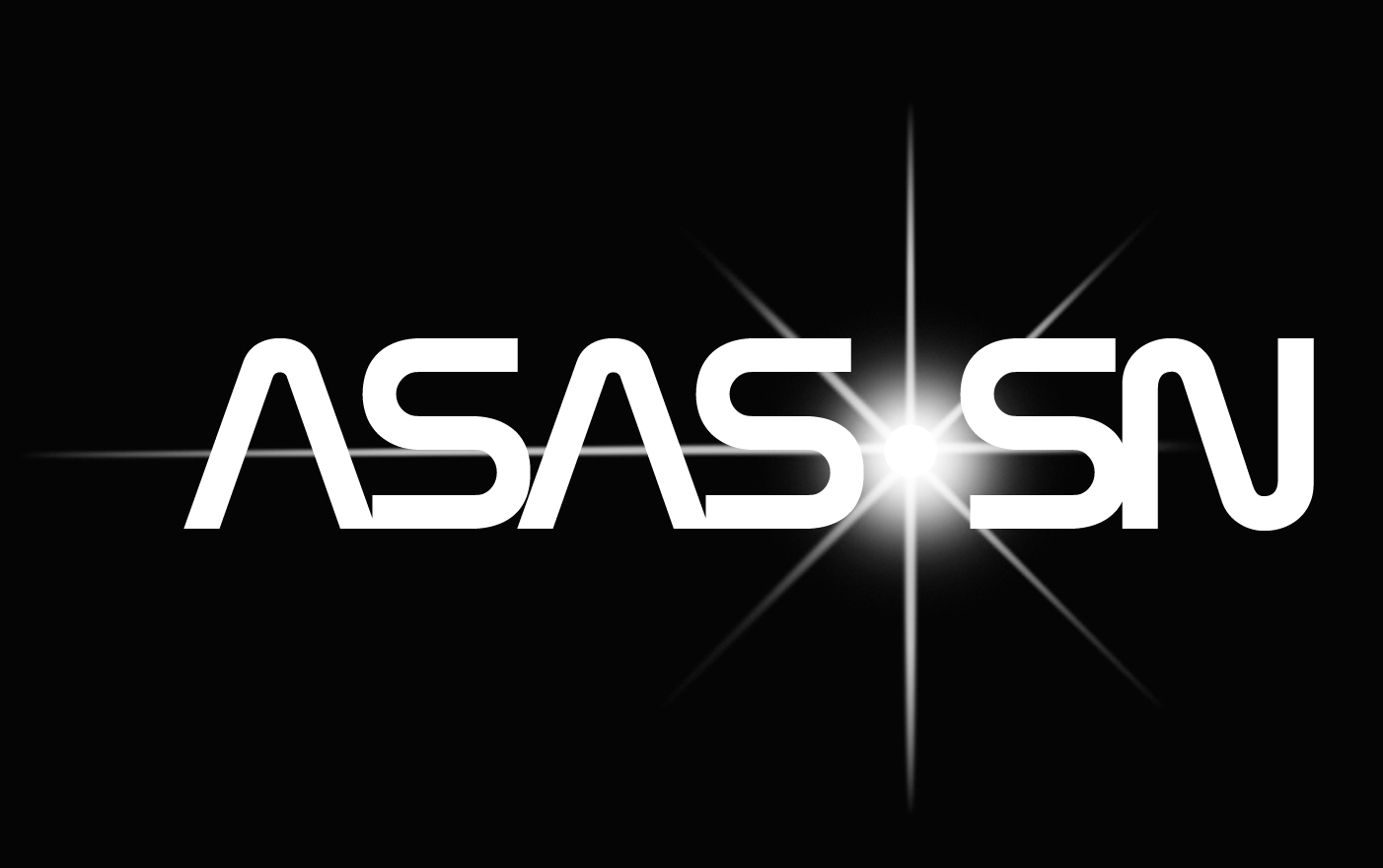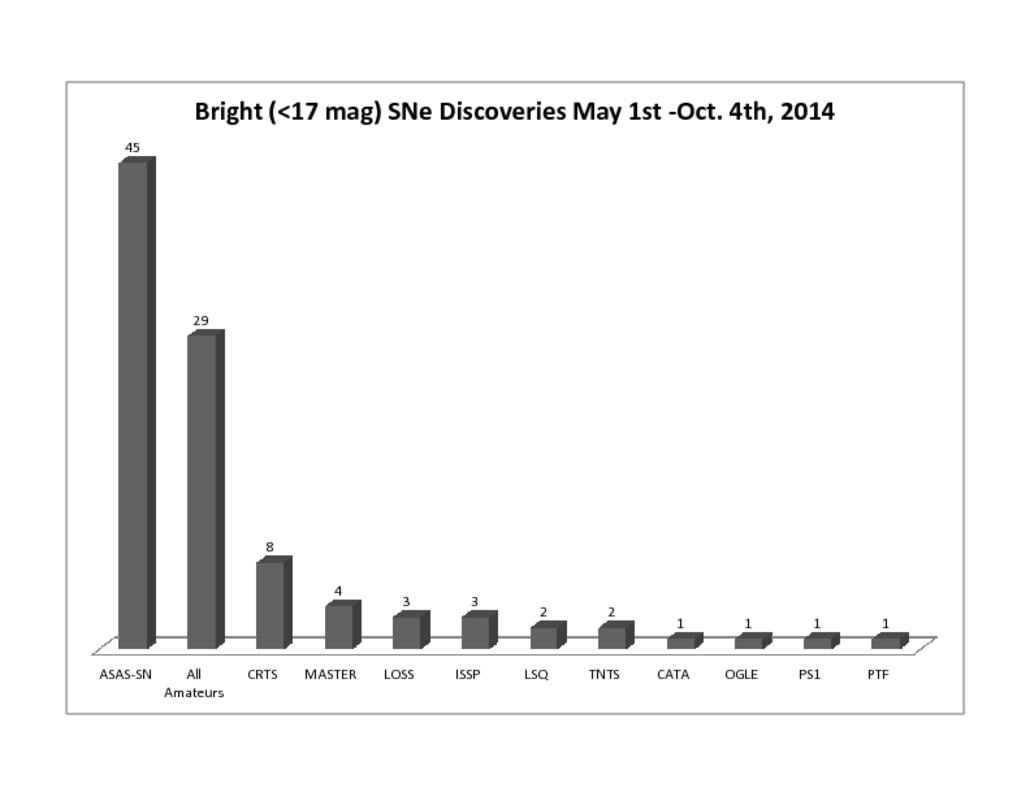
Assassin Picture of the Week
 | APOW Assassin Picture of the Week |

|
|
We have not updated this page for a while now, being very busy discovering many bright supernovae and many other transients, including almost 200 new CVs since April 2013. But it is good to take a break now and then and to check how one is doing. One of the major scientific goals on ASAS-SN is to produce as complete as possible census of bright, nearby supernovae, and to study these supernoave and their host galaxies in detail. Since May 1st, 2014, using four telescopes in Hawaii and two telescopes in Chile, we have been finding 8-10 bright (V<17) supernovae per month. That does not seem like much, compared to more than 1000 SNe found on the sky every year, but it turns out that in the last few months ASAS-SN continued to discover about half of all the bright SNe on the sky. This is illustrated in the plot above, which is using data from the Bright Supernova, a most useful website run by David Bishop. We select all the supernovae that peaked at 17.0 mag or above. Then we plot how many supernovae were discovered by different groups. There were exactly 100 such SNe between May 1st, 2014 ("Cassius" in Chile becoming operational) and Oct. 4th, 2014, when we compiled the stats. Of that 100 SNe total, ASAS-SN discovered 45, amateur astronomers discovered 29, and all the other professional searches combined discovered 26. Obviously such split would not hold were we to look at fainter supernovae, where PS1 alone has reported 400 SN candidates in 2014. But bright and nearby SNe are especially valuable, as they and their host galaxies are easy to study uing modest size, 1 to 4-m diameter telescopes. One thing that needs to be stressed is a continued, great contribution of amateur astronomers to nearby supernova searches. Looking at the five brightest SNe in that time period, four (SN 2014bv, SN 2014dg, SN 2014df and SN 2014cx) were discovered by amateur astronomers and one (ASASSN-14az) by ASAS-SN. Similarly, the brightest supernova of 2014, SN 2014J in M82, was not discovered by the professional searches. In case of ASAS-SN, a very important part of our project is the follow-up effort with bigger telescopes to get confirmation imaging (our images have 7.5" pixels). We are fortunate to have a number of "professional amateur astronomers" working with us on ASAS-SN SN confirmation effort: J. Brimacombe (Coral Towers Observatory), E. Conseil (Association Francaise des Observateurs d'Etoiles Variables), I. Cruz (Cruz Observatory, Ohio), J. Hissong (Columbus Astronomical Society, Ohio), S. Kiyota (Variable Star Observers League in Japan), L. A. G. Monard (Klein Karoo Observatory, Western Cape, South Africa), B. Nicholls (Mt. Vernon Obs., New Zealand), J. Nicolas (Groupe SNAUDE, France) and W. Wiethoff (University of Minnesota, Duluth) (professional astronomers are working with us as well). They have already played crucial role in many ASAS-SN SN discoveries, as you can see from these Telegrams, and we are hoping for their continued collaboration for years to come. |
Back to ASAS-SN page.
See previous APOWs:
Bright Supernovae: ASAS-SN Contribution
First Light on the Small Magellanic Cloud from Chile
Congratulations to Tom and Jacob!
ASASSN-13dn: Spectra from a New Instrument
ASASSN-14ae, A Very Luminous Transient
Our Latest Paper, in Video Form
Host Galaxies of ASAS-SN Supernovae
Back in Real-Time Discovery Business!
Active (Some Less, Some More) Galactic Nuclei with ASAS-SN
Swift
Ultraviolet and Optical Follow-Up of ASASSN-13dl, Our Latest
Supernova
Dramatic AGN Outburst in NGC 2617
Two ASAS-SN Views of Orion Nebula
AAVSO Observations of Cataclysmic Variable ASASSN-13ck
Two ASAS-SN Supernovae in One Day!
Extreme M-dwarf Flare Observed by ASAS-SN;
Multiband photometric follow-up of ASASSN-13aw (SN 2013dr);
How ASAS-SN Discovers Supernovae: Case of Supernova ASASSN-13bb;
NGC 2617: Dramatic Seyfert Type Change;
ASASSN-13/SN 2013da: Our First Supernova Three Weeks Later;
This homepage is maintained by Tom Holoien, Ben Shappee and Kris Stanek.
Updated Wed Oct 8 15:41:16 EDT 201